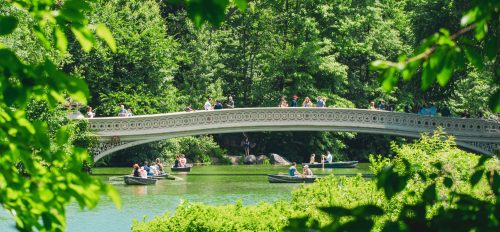Bridges of Central Park

Bow Bridge
One of the most brilliant aspects of the Olmsted-Vaux plan for Central Park was hiding the transverse roads from the perspective of the park goer. The sinking of the roads below view (and in one case tunneling because one had to be carved out of the schist of Vista Rock on the 79th Street transverse), was their innovative solution. To grasp how brilliant, we need only glance at the failure of the city highway planners of the 1930’s and 1940’s to follow the example. A walk in Van Cortlandt Park in the Bronx will make it obvious that much of the Henry Hudson Parkway, as it goes through that magnificent park, could have been given a long tunnel. We might add that the Major Deegan Expressway in the same park could have been given a long tunnel or several tunnels. Yet another sample of the destruction of the same era is found in Cunningham Park in Queens. Admittedly, the answer was not as easy as in Central Park, but the Clearview Expressway could have been so handled that it would not be what it is today, a Chinese wall down the park’s center. The Olmsted-Vaux precedent held not the slightest interest to the planning experts of a generation and more ago.
What is most rewarding about the bridges over the transverse roads is their width, an average of 119 feet. Even the ones carrying only a footpath are wide enough to have space for ample planting to screen the traffic below.
These bridges and the one tunnel are, in a sense, not part of the park, any more than the transverse roads. The bridges which count are those within the park proper. The existence of most of those bridges resulted from a major change in the design shortly after Olmsted and Vaux obtained their commission. True, their Greensward plan had drives and footpaths – – few of the latter were indicated in detail — and few park bridges were shown. The change, and it was made at the suggestion of the Commissioners, was the introduction of a bridle path. With the Commissioners numbering such figures as the banker August Belmont, horseback riding, much as carriage driving, was a necessity. Besides, there were the famous examples of London’s Hyde Park with its Rotten Row and the Bois de Boulogne of Paris where fashion dictated a daily cavalcade. This meant that, to the drive and footpath, was added a third right-of-way, the bridle path. The two planners had, from the start, mandated a separation of traffic, easy enough to do with two kinds of right-of-way; now a third was to make for more crossings. In the days before the traffic light a bridge was the only answer.
Originally, there were plans for seven bridges, two tunnels, a masonry bridge, and a footbridge within the park and over the transverse roads. Several of these were given up, and wood gave way to masonry. Then nineteen bridges were added, including the Arcade beneath the drive at the Terrace on the Lake. By 1872 there were thirty-four in the park. In addition, two were yet to be built, and at a later date three other bridges were added, one over the bridle path at the West 77th Street entrance, a second at West 90th Street, and a third at Frederick Douglass Circle.
What is astonishing is how successfully the bridges were made inconspicuous if not concealed. The one striking exception is, of course, Bow Bridge over the Lake. For the others the park visitor, unless he or she is an aficionado, has to pause and think where they are to be found. We tend to neglect them because of the traffic lights. Even more, we remain so taken by the park’s overall quality of landscape, the lakes and streams, glades, woodlands, sweep of lawn, that the bridges appear only a minor adjunct, when they are works of art in themselves and in their setting.
Olmsted and Vaux had a very strong conviction that structures had no place in a park, unless they served a park purpose. For example, they were against having a zoo in the park. If the Belvedere Castle was built it was only because Vista Rock, on which it stands, had disappeared behind a screen of greenery, the Ramble. Vista Rock had served as the focal point of the Mall, and the Belvedere took its place with its tower still to be seen above the trees of the Ramble.
Of course, the bridges threatened to be a major intrusion. For that reason not only did the two planners have to site them for convenience, they had to be placed in such a way that they could not be seen until the promenader was at them. A typical one is Willowdell Arch. How many would know that it exists except for the fact that it is near the statue of “Balto,” the legendary Alaskan husky? Siting and building the structure was just part of the work; skillful grading — to be sure, almost the whole park was regraded — resulted in concealment.
Hiding the bridges was, in part, a breakaway from the picturesque tradition. In the great English private estates of the 18th century bridges were, along with temples, a conspicuous ornament. Palladio’s design for the Rialto Bridge in Venice, never built, was familiar to the landowners as it is found in the Italian architect’s Four Books of Architecture, and a number of versions of it can be seen in England. In a sense, Olmsted and Vaux had gone a step beyond their predecessors in their vision of a structureless park, actually achieved by Jens Jensen in the Forest Preserve of Cook County, Illinois, in the 1920’s.
Design of the bridges fell to Vaux, and it is testimony to his skill that no two of them are alike. This, too, is part of the picturesque tradition with its accent on constant variety. The materials adopted were familiar to New Yorkers of the time: Philadelphia pressed brick (instead of Husdon River brick); browstone from the Connecticut Valley; sandstone from New Brunswick;* and schist from the park itself. In order to convey a pronounced rustic note he even used several large uncut blocks of schist from the park. The most spectacular example is the Huddlestone Arch, in the park’s north end.
At the other end of the design spectrum are the bridges that are made of cast iron, a favorite of the era, where the architect Jacob Wrey Mould shares honors with Vaux. The parts to be cast would be drawn in exact detail and then sent to the foundry. Large sections, even half an archway, were cast. Cast and wrought iron were innovative. Phosphorous in the iron alloy made fine detail possible in casting. The five remaining bridges in Central Park are outstanding as ornamental iron works in public use. They are also, with the exception of an iron bridge over Dunlap’s Creek in Brownsville, Pennsylvania, the oldest cast iron bridges in America.
The bridges of Central Park vary in style, although a Gothic and Romanesque note seems to touch most of them. At Bethesda Terrace it would appear to be Romanesque with extraordinary realistic detail. The Gothic is to be seen in a beautiful small bridge of cast iron over the bridle path just north of the Reservoir, Gothic Bridge.
They are a constant reminder that the goal of Olmsted and Vaux was to offer as pleasing a contrast as in their power to the city of brick and stone round about. For that reason they were convinced that nature, without artifacts, was the only answer. Any intrusion, unless serving a park use, detracted from the park’s environment, to adopt a modern term. The result is that the New Yorker, let us say with Anthony Trollope’s permission, can still boast that Central Park is one of the wonders of its kind.
Source Material for Bridge Articles: Courtesy of The Greensward Foundation
Bow Bridge

Gapstow Bridge




